Performance Related Pay and Motivation
VerifiedAdded on 2020/06/04
|12
|3531
|371
AI Summary
This assignment delves into the effectiveness of performance-related pay (PRP) in motivating employees. It explores the theoretical underpinnings of PRP, considering models like goal-setting and expectancy theory. The analysis examines the potential crowding out effect of PRP on intrinsic motivation. Furthermore, it proposes practical strategies for organizations seeking to implement effective PRP systems, emphasizing regular performance reviews, clear objectives, and alternative measures of individual performance related pay (IPRP).
Contribute Materials
Your contribution can guide someone’s learning journey. Share your
documents today.

REWARD
MANAGEMENT
MANAGEMENT
Secure Best Marks with AI Grader
Need help grading? Try our AI Grader for instant feedback on your assignments.
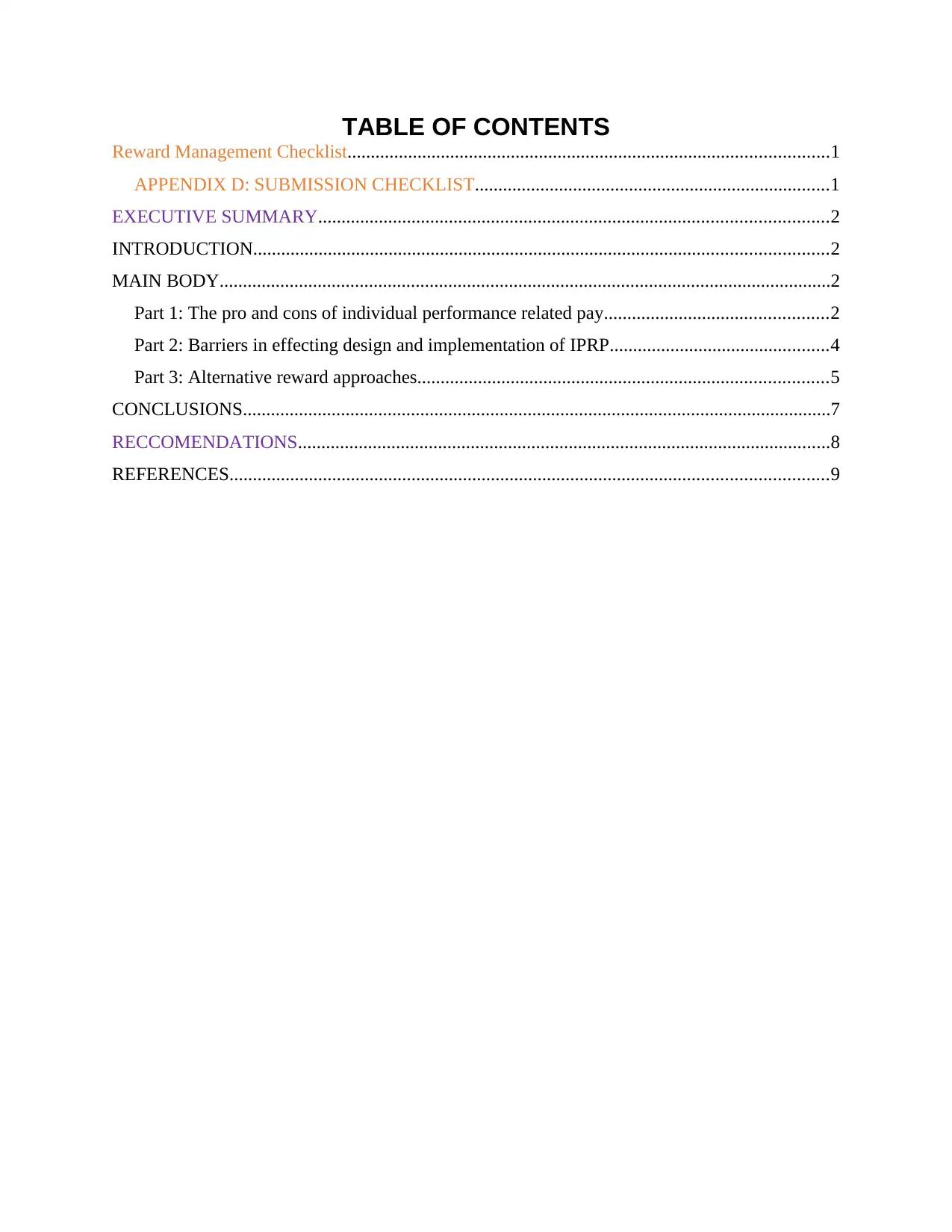
TABLE OF CONTENTS
Reward Management Checklist.......................................................................................................1
APPENDIX D: SUBMISSION CHECKLIST............................................................................1
EXECUTIVE SUMMARY.............................................................................................................2
INTRODUCTION...........................................................................................................................2
MAIN BODY...................................................................................................................................2
Part 1: The pro and cons of individual performance related pay................................................2
Part 2: Barriers in effecting design and implementation of IPRP...............................................4
Part 3: Alternative reward approaches........................................................................................5
CONCLUSIONS..............................................................................................................................7
RECCOMENDATIONS..................................................................................................................8
REFERENCES................................................................................................................................9
Reward Management Checklist.......................................................................................................1
APPENDIX D: SUBMISSION CHECKLIST............................................................................1
EXECUTIVE SUMMARY.............................................................................................................2
INTRODUCTION...........................................................................................................................2
MAIN BODY...................................................................................................................................2
Part 1: The pro and cons of individual performance related pay................................................2
Part 2: Barriers in effecting design and implementation of IPRP...............................................4
Part 3: Alternative reward approaches........................................................................................5
CONCLUSIONS..............................................................................................................................7
RECCOMENDATIONS..................................................................................................................8
REFERENCES................................................................................................................................9
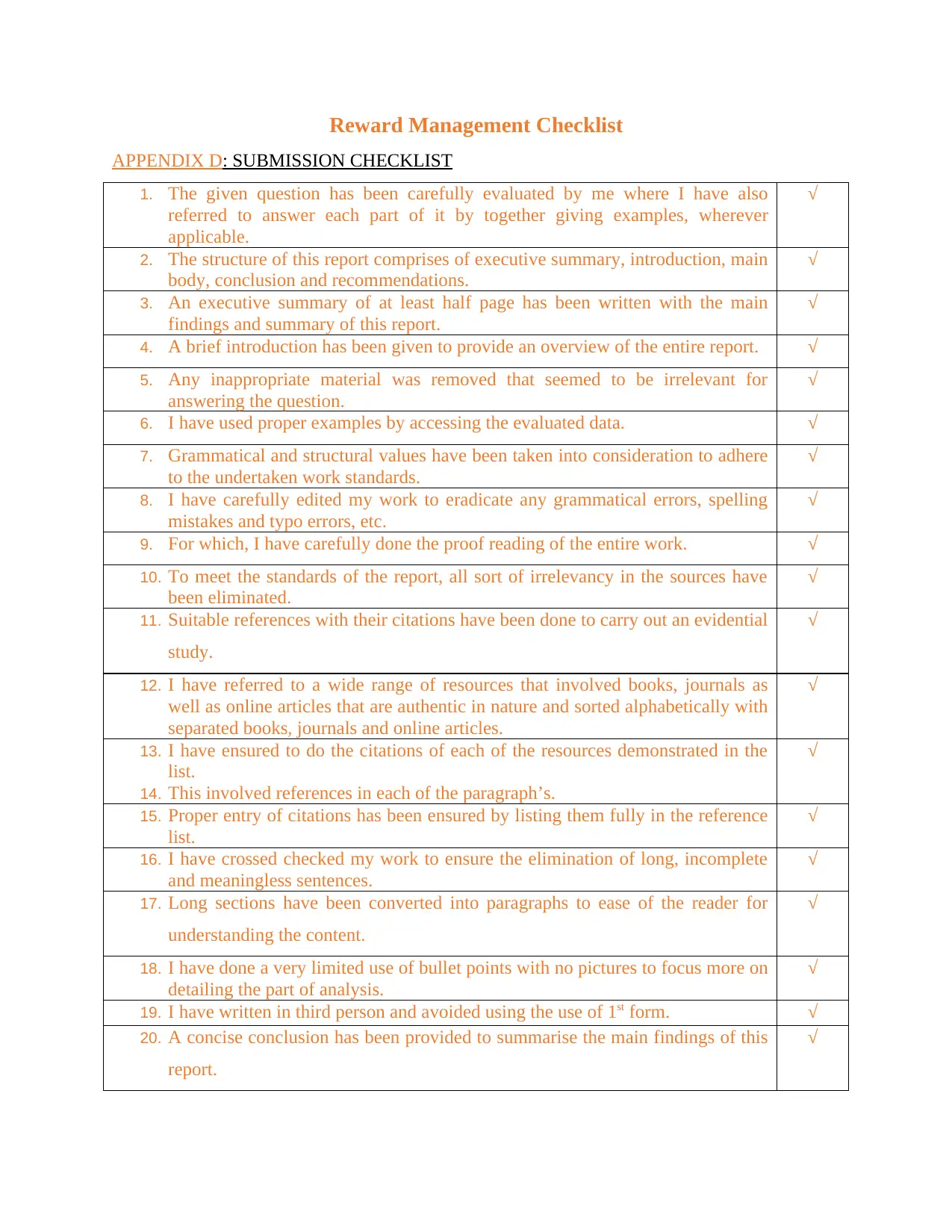
Reward Management Checklist
APPENDIX D: SUBMISSION CHECKLIST
1. The given question has been carefully evaluated by me where I have also
referred to answer each part of it by together giving examples, wherever
applicable.
√
2. The structure of this report comprises of executive summary, introduction, main
body, conclusion and recommendations.
√
3. An executive summary of at least half page has been written with the main
findings and summary of this report.
√
4. A brief introduction has been given to provide an overview of the entire report. √
5. Any inappropriate material was removed that seemed to be irrelevant for
answering the question.
√
6. I have used proper examples by accessing the evaluated data. √
7. Grammatical and structural values have been taken into consideration to adhere
to the undertaken work standards.
√
8. I have carefully edited my work to eradicate any grammatical errors, spelling
mistakes and typo errors, etc.
√
9. For which, I have carefully done the proof reading of the entire work. √
10. To meet the standards of the report, all sort of irrelevancy in the sources have
been eliminated.
√
11. Suitable references with their citations have been done to carry out an evidential
study.
√
12. I have referred to a wide range of resources that involved books, journals as
well as online articles that are authentic in nature and sorted alphabetically with
separated books, journals and online articles.
√
13. I have ensured to do the citations of each of the resources demonstrated in the
list.
14. This involved references in each of the paragraph’s.
√
15. Proper entry of citations has been ensured by listing them fully in the reference
list.
√
16. I have crossed checked my work to ensure the elimination of long, incomplete
and meaningless sentences.
√
17. Long sections have been converted into paragraphs to ease of the reader for
understanding the content.
√
18. I have done a very limited use of bullet points with no pictures to focus more on
detailing the part of analysis.
√
19. I have written in third person and avoided using the use of 1st form. √
20. A concise conclusion has been provided to summarise the main findings of this
report.
√
APPENDIX D: SUBMISSION CHECKLIST
1. The given question has been carefully evaluated by me where I have also
referred to answer each part of it by together giving examples, wherever
applicable.
√
2. The structure of this report comprises of executive summary, introduction, main
body, conclusion and recommendations.
√
3. An executive summary of at least half page has been written with the main
findings and summary of this report.
√
4. A brief introduction has been given to provide an overview of the entire report. √
5. Any inappropriate material was removed that seemed to be irrelevant for
answering the question.
√
6. I have used proper examples by accessing the evaluated data. √
7. Grammatical and structural values have been taken into consideration to adhere
to the undertaken work standards.
√
8. I have carefully edited my work to eradicate any grammatical errors, spelling
mistakes and typo errors, etc.
√
9. For which, I have carefully done the proof reading of the entire work. √
10. To meet the standards of the report, all sort of irrelevancy in the sources have
been eliminated.
√
11. Suitable references with their citations have been done to carry out an evidential
study.
√
12. I have referred to a wide range of resources that involved books, journals as
well as online articles that are authentic in nature and sorted alphabetically with
separated books, journals and online articles.
√
13. I have ensured to do the citations of each of the resources demonstrated in the
list.
14. This involved references in each of the paragraph’s.
√
15. Proper entry of citations has been ensured by listing them fully in the reference
list.
√
16. I have crossed checked my work to ensure the elimination of long, incomplete
and meaningless sentences.
√
17. Long sections have been converted into paragraphs to ease of the reader for
understanding the content.
√
18. I have done a very limited use of bullet points with no pictures to focus more on
detailing the part of analysis.
√
19. I have written in third person and avoided using the use of 1st form. √
20. A concise conclusion has been provided to summarise the main findings of this
report.
√
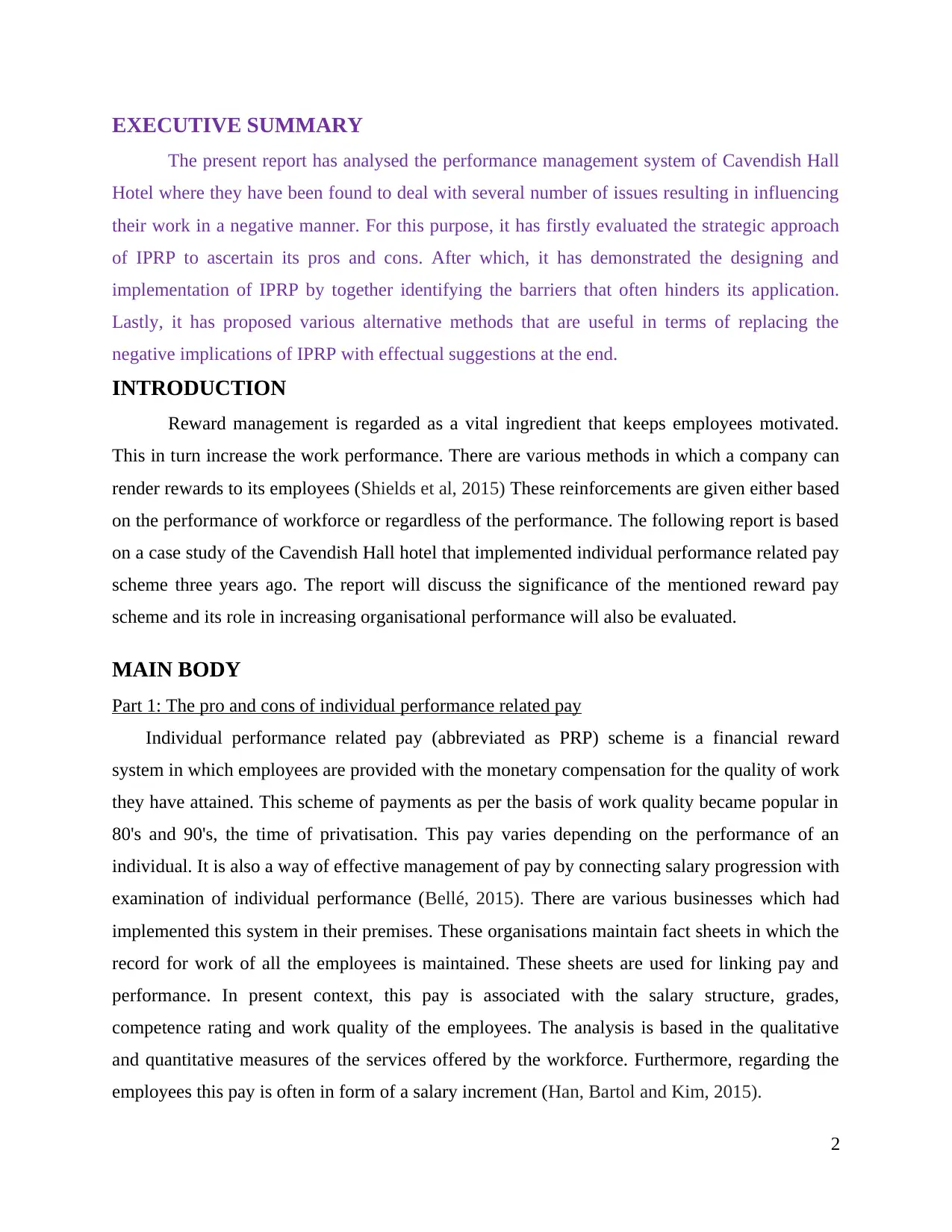
EXECUTIVE SUMMARY
The present report has analysed the performance management system of Cavendish Hall
Hotel where they have been found to deal with several number of issues resulting in influencing
their work in a negative manner. For this purpose, it has firstly evaluated the strategic approach
of IPRP to ascertain its pros and cons. After which, it has demonstrated the designing and
implementation of IPRP by together identifying the barriers that often hinders its application.
Lastly, it has proposed various alternative methods that are useful in terms of replacing the
negative implications of IPRP with effectual suggestions at the end.
INTRODUCTION
Reward management is regarded as a vital ingredient that keeps employees motivated.
This in turn increase the work performance. There are various methods in which a company can
render rewards to its employees (Shields et al, 2015) These reinforcements are given either based
on the performance of workforce or regardless of the performance. The following report is based
on a case study of the Cavendish Hall hotel that implemented individual performance related pay
scheme three years ago. The report will discuss the significance of the mentioned reward pay
scheme and its role in increasing organisational performance will also be evaluated.
MAIN BODY
Part 1: The pro and cons of individual performance related pay
Individual performance related pay (abbreviated as PRP) scheme is a financial reward
system in which employees are provided with the monetary compensation for the quality of work
they have attained. This scheme of payments as per the basis of work quality became popular in
80's and 90's, the time of privatisation. This pay varies depending on the performance of an
individual. It is also a way of effective management of pay by connecting salary progression with
examination of individual performance (Bellé, 2015). There are various businesses which had
implemented this system in their premises. These organisations maintain fact sheets in which the
record for work of all the employees is maintained. These sheets are used for linking pay and
performance. In present context, this pay is associated with the salary structure, grades,
competence rating and work quality of the employees. The analysis is based in the qualitative
and quantitative measures of the services offered by the workforce. Furthermore, regarding the
employees this pay is often in form of a salary increment (Han, Bartol and Kim, 2015).
2
The present report has analysed the performance management system of Cavendish Hall
Hotel where they have been found to deal with several number of issues resulting in influencing
their work in a negative manner. For this purpose, it has firstly evaluated the strategic approach
of IPRP to ascertain its pros and cons. After which, it has demonstrated the designing and
implementation of IPRP by together identifying the barriers that often hinders its application.
Lastly, it has proposed various alternative methods that are useful in terms of replacing the
negative implications of IPRP with effectual suggestions at the end.
INTRODUCTION
Reward management is regarded as a vital ingredient that keeps employees motivated.
This in turn increase the work performance. There are various methods in which a company can
render rewards to its employees (Shields et al, 2015) These reinforcements are given either based
on the performance of workforce or regardless of the performance. The following report is based
on a case study of the Cavendish Hall hotel that implemented individual performance related pay
scheme three years ago. The report will discuss the significance of the mentioned reward pay
scheme and its role in increasing organisational performance will also be evaluated.
MAIN BODY
Part 1: The pro and cons of individual performance related pay
Individual performance related pay (abbreviated as PRP) scheme is a financial reward
system in which employees are provided with the monetary compensation for the quality of work
they have attained. This scheme of payments as per the basis of work quality became popular in
80's and 90's, the time of privatisation. This pay varies depending on the performance of an
individual. It is also a way of effective management of pay by connecting salary progression with
examination of individual performance (Bellé, 2015). There are various businesses which had
implemented this system in their premises. These organisations maintain fact sheets in which the
record for work of all the employees is maintained. These sheets are used for linking pay and
performance. In present context, this pay is associated with the salary structure, grades,
competence rating and work quality of the employees. The analysis is based in the qualitative
and quantitative measures of the services offered by the workforce. Furthermore, regarding the
employees this pay is often in form of a salary increment (Han, Bartol and Kim, 2015).
2
Secure Best Marks with AI Grader
Need help grading? Try our AI Grader for instant feedback on your assignments.
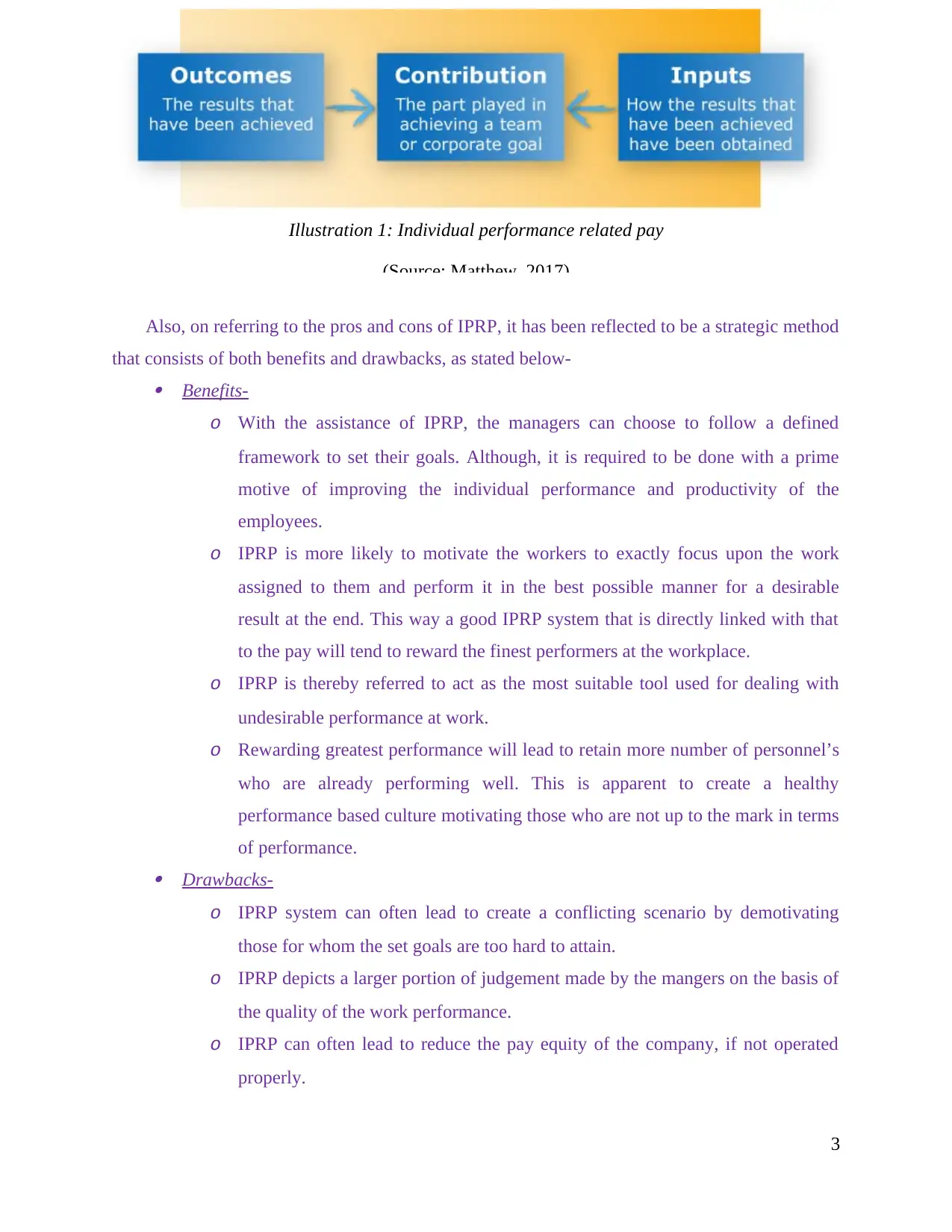
Also, on referring to the pros and cons of IPRP, it has been reflected to be a strategic method
that consists of both benefits and drawbacks, as stated below- Benefits-
o With the assistance of IPRP, the managers can choose to follow a defined
framework to set their goals. Although, it is required to be done with a prime
motive of improving the individual performance and productivity of the
employees.
o IPRP is more likely to motivate the workers to exactly focus upon the work
assigned to them and perform it in the best possible manner for a desirable
result at the end. This way a good IPRP system that is directly linked with that
to the pay will tend to reward the finest performers at the workplace.
o IPRP is thereby referred to act as the most suitable tool used for dealing with
undesirable performance at work.
o Rewarding greatest performance will lead to retain more number of personnel’s
who are already performing well. This is apparent to create a healthy
performance based culture motivating those who are not up to the mark in terms
of performance. Drawbacks-
o IPRP system can often lead to create a conflicting scenario by demotivating
those for whom the set goals are too hard to attain.
o IPRP depicts a larger portion of judgement made by the mangers on the basis of
the quality of the work performance.
o IPRP can often lead to reduce the pay equity of the company, if not operated
properly.
3
Illustration 1: Individual performance related pay
(Source: Matthew, 2017)
that consists of both benefits and drawbacks, as stated below- Benefits-
o With the assistance of IPRP, the managers can choose to follow a defined
framework to set their goals. Although, it is required to be done with a prime
motive of improving the individual performance and productivity of the
employees.
o IPRP is more likely to motivate the workers to exactly focus upon the work
assigned to them and perform it in the best possible manner for a desirable
result at the end. This way a good IPRP system that is directly linked with that
to the pay will tend to reward the finest performers at the workplace.
o IPRP is thereby referred to act as the most suitable tool used for dealing with
undesirable performance at work.
o Rewarding greatest performance will lead to retain more number of personnel’s
who are already performing well. This is apparent to create a healthy
performance based culture motivating those who are not up to the mark in terms
of performance. Drawbacks-
o IPRP system can often lead to create a conflicting scenario by demotivating
those for whom the set goals are too hard to attain.
o IPRP depicts a larger portion of judgement made by the mangers on the basis of
the quality of the work performance.
o IPRP can often lead to reduce the pay equity of the company, if not operated
properly.
3
Illustration 1: Individual performance related pay
(Source: Matthew, 2017)
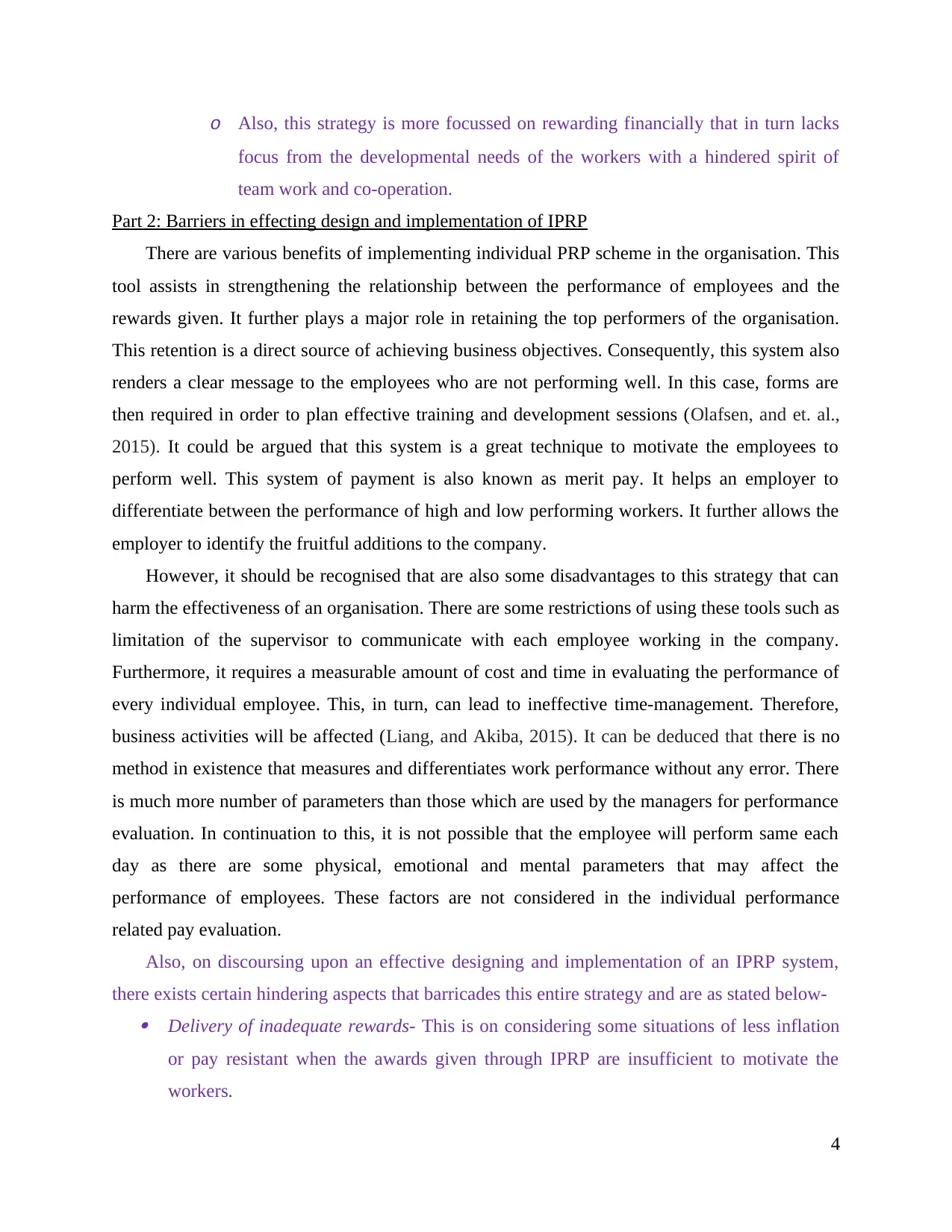
o Also, this strategy is more focussed on rewarding financially that in turn lacks
focus from the developmental needs of the workers with a hindered spirit of
team work and co-operation.
Part 2: Barriers in effecting design and implementation of IPRP
There are various benefits of implementing individual PRP scheme in the organisation. This
tool assists in strengthening the relationship between the performance of employees and the
rewards given. It further plays a major role in retaining the top performers of the organisation.
This retention is a direct source of achieving business objectives. Consequently, this system also
renders a clear message to the employees who are not performing well. In this case, forms are
then required in order to plan effective training and development sessions (Olafsen, and et. al.,
2015). It could be argued that this system is a great technique to motivate the employees to
perform well. This system of payment is also known as merit pay. It helps an employer to
differentiate between the performance of high and low performing workers. It further allows the
employer to identify the fruitful additions to the company.
However, it should be recognised that are also some disadvantages to this strategy that can
harm the effectiveness of an organisation. There are some restrictions of using these tools such as
limitation of the supervisor to communicate with each employee working in the company.
Furthermore, it requires a measurable amount of cost and time in evaluating the performance of
every individual employee. This, in turn, can lead to ineffective time-management. Therefore,
business activities will be affected (Liang, and Akiba, 2015). It can be deduced that there is no
method in existence that measures and differentiates work performance without any error. There
is much more number of parameters than those which are used by the managers for performance
evaluation. In continuation to this, it is not possible that the employee will perform same each
day as there are some physical, emotional and mental parameters that may affect the
performance of employees. These factors are not considered in the individual performance
related pay evaluation.
Also, on discoursing upon an effective designing and implementation of an IPRP system,
there exists certain hindering aspects that barricades this entire strategy and are as stated below- Delivery of inadequate rewards- This is on considering some situations of less inflation
or pay resistant when the awards given through IPRP are insufficient to motivate the
workers.
4
focus from the developmental needs of the workers with a hindered spirit of
team work and co-operation.
Part 2: Barriers in effecting design and implementation of IPRP
There are various benefits of implementing individual PRP scheme in the organisation. This
tool assists in strengthening the relationship between the performance of employees and the
rewards given. It further plays a major role in retaining the top performers of the organisation.
This retention is a direct source of achieving business objectives. Consequently, this system also
renders a clear message to the employees who are not performing well. In this case, forms are
then required in order to plan effective training and development sessions (Olafsen, and et. al.,
2015). It could be argued that this system is a great technique to motivate the employees to
perform well. This system of payment is also known as merit pay. It helps an employer to
differentiate between the performance of high and low performing workers. It further allows the
employer to identify the fruitful additions to the company.
However, it should be recognised that are also some disadvantages to this strategy that can
harm the effectiveness of an organisation. There are some restrictions of using these tools such as
limitation of the supervisor to communicate with each employee working in the company.
Furthermore, it requires a measurable amount of cost and time in evaluating the performance of
every individual employee. This, in turn, can lead to ineffective time-management. Therefore,
business activities will be affected (Liang, and Akiba, 2015). It can be deduced that there is no
method in existence that measures and differentiates work performance without any error. There
is much more number of parameters than those which are used by the managers for performance
evaluation. In continuation to this, it is not possible that the employee will perform same each
day as there are some physical, emotional and mental parameters that may affect the
performance of employees. These factors are not considered in the individual performance
related pay evaluation.
Also, on discoursing upon an effective designing and implementation of an IPRP system,
there exists certain hindering aspects that barricades this entire strategy and are as stated below- Delivery of inadequate rewards- This is on considering some situations of less inflation
or pay resistant when the awards given through IPRP are insufficient to motivate the
workers.
4
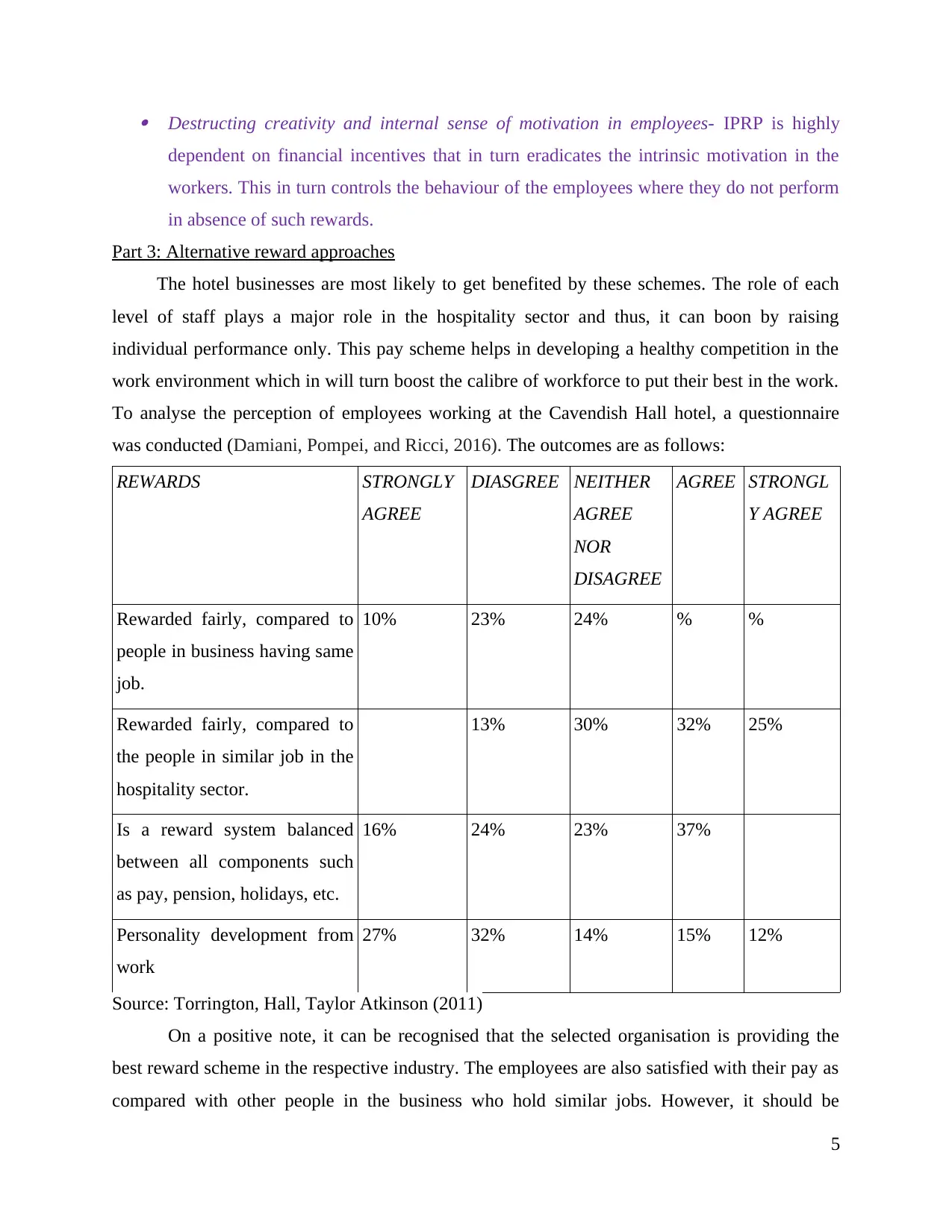
Destructing creativity and internal sense of motivation in employees- IPRP is highly
dependent on financial incentives that in turn eradicates the intrinsic motivation in the
workers. This in turn controls the behaviour of the employees where they do not perform
in absence of such rewards.
Part 3: Alternative reward approaches
The hotel businesses are most likely to get benefited by these schemes. The role of each
level of staff plays a major role in the hospitality sector and thus, it can boon by raising
individual performance only. This pay scheme helps in developing a healthy competition in the
work environment which in will turn boost the calibre of workforce to put their best in the work.
To analyse the perception of employees working at the Cavendish Hall hotel, a questionnaire
was conducted (Damiani, Pompei, and Ricci, 2016). The outcomes are as follows:
REWARDS STRONGLY
AGREE
DIASGREE NEITHER
AGREE
NOR
DISAGREE
AGREE STRONGL
Y AGREE
Rewarded fairly, compared to
people in business having same
job.
10% 23% 24% % %
Rewarded fairly, compared to
the people in similar job in the
hospitality sector.
13% 30% 32% 25%
Is a reward system balanced
between all components such
as pay, pension, holidays, etc.
16% 24% 23% 37%
Personality development from
work
27% 32% 14% 15% 12%
Source: Torrington, Hall, Taylor Atkinson (2011)
On a positive note, it can be recognised that the selected organisation is providing the
best reward scheme in the respective industry. The employees are also satisfied with their pay as
compared with other people in the business who hold similar jobs. However, it should be
5
dependent on financial incentives that in turn eradicates the intrinsic motivation in the
workers. This in turn controls the behaviour of the employees where they do not perform
in absence of such rewards.
Part 3: Alternative reward approaches
The hotel businesses are most likely to get benefited by these schemes. The role of each
level of staff plays a major role in the hospitality sector and thus, it can boon by raising
individual performance only. This pay scheme helps in developing a healthy competition in the
work environment which in will turn boost the calibre of workforce to put their best in the work.
To analyse the perception of employees working at the Cavendish Hall hotel, a questionnaire
was conducted (Damiani, Pompei, and Ricci, 2016). The outcomes are as follows:
REWARDS STRONGLY
AGREE
DIASGREE NEITHER
AGREE
NOR
DISAGREE
AGREE STRONGL
Y AGREE
Rewarded fairly, compared to
people in business having same
job.
10% 23% 24% % %
Rewarded fairly, compared to
the people in similar job in the
hospitality sector.
13% 30% 32% 25%
Is a reward system balanced
between all components such
as pay, pension, holidays, etc.
16% 24% 23% 37%
Personality development from
work
27% 32% 14% 15% 12%
Source: Torrington, Hall, Taylor Atkinson (2011)
On a positive note, it can be recognised that the selected organisation is providing the
best reward scheme in the respective industry. The employees are also satisfied with their pay as
compared with other people in the business who hold similar jobs. However, it should be
5
Paraphrase This Document
Need a fresh take? Get an instant paraphrase of this document with our AI Paraphraser
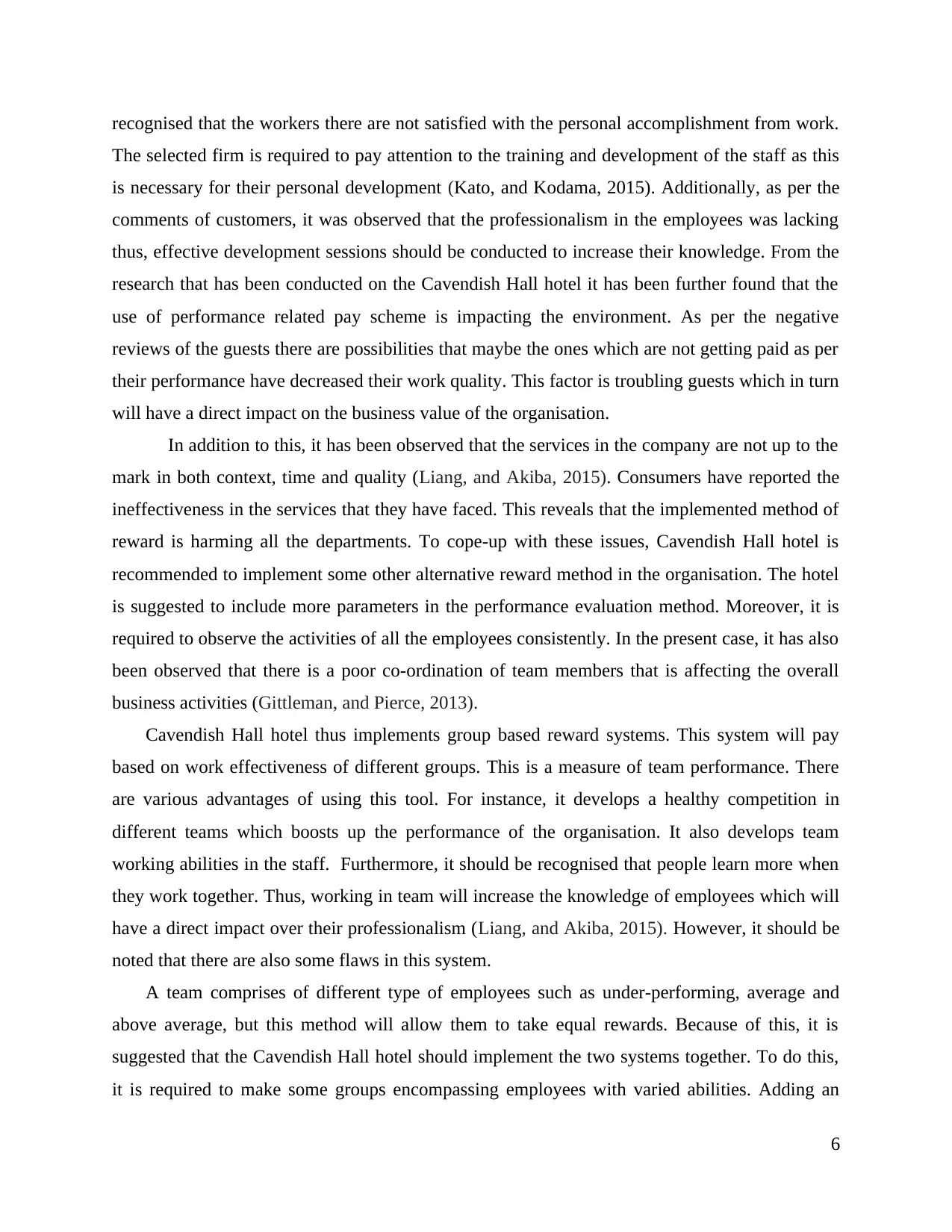
recognised that the workers there are not satisfied with the personal accomplishment from work.
The selected firm is required to pay attention to the training and development of the staff as this
is necessary for their personal development (Kato, and Kodama, 2015). Additionally, as per the
comments of customers, it was observed that the professionalism in the employees was lacking
thus, effective development sessions should be conducted to increase their knowledge. From the
research that has been conducted on the Cavendish Hall hotel it has been further found that the
use of performance related pay scheme is impacting the environment. As per the negative
reviews of the guests there are possibilities that maybe the ones which are not getting paid as per
their performance have decreased their work quality. This factor is troubling guests which in turn
will have a direct impact on the business value of the organisation.
In addition to this, it has been observed that the services in the company are not up to the
mark in both context, time and quality (Liang, and Akiba, 2015). Consumers have reported the
ineffectiveness in the services that they have faced. This reveals that the implemented method of
reward is harming all the departments. To cope-up with these issues, Cavendish Hall hotel is
recommended to implement some other alternative reward method in the organisation. The hotel
is suggested to include more parameters in the performance evaluation method. Moreover, it is
required to observe the activities of all the employees consistently. In the present case, it has also
been observed that there is a poor co-ordination of team members that is affecting the overall
business activities (Gittleman, and Pierce, 2013).
Cavendish Hall hotel thus implements group based reward systems. This system will pay
based on work effectiveness of different groups. This is a measure of team performance. There
are various advantages of using this tool. For instance, it develops a healthy competition in
different teams which boosts up the performance of the organisation. It also develops team
working abilities in the staff. Furthermore, it should be recognised that people learn more when
they work together. Thus, working in team will increase the knowledge of employees which will
have a direct impact over their professionalism (Liang, and Akiba, 2015). However, it should be
noted that there are also some flaws in this system.
A team comprises of different type of employees such as under-performing, average and
above average, but this method will allow them to take equal rewards. Because of this, it is
suggested that the Cavendish Hall hotel should implement the two systems together. To do this,
it is required to make some groups encompassing employees with varied abilities. Adding an
6
The selected firm is required to pay attention to the training and development of the staff as this
is necessary for their personal development (Kato, and Kodama, 2015). Additionally, as per the
comments of customers, it was observed that the professionalism in the employees was lacking
thus, effective development sessions should be conducted to increase their knowledge. From the
research that has been conducted on the Cavendish Hall hotel it has been further found that the
use of performance related pay scheme is impacting the environment. As per the negative
reviews of the guests there are possibilities that maybe the ones which are not getting paid as per
their performance have decreased their work quality. This factor is troubling guests which in turn
will have a direct impact on the business value of the organisation.
In addition to this, it has been observed that the services in the company are not up to the
mark in both context, time and quality (Liang, and Akiba, 2015). Consumers have reported the
ineffectiveness in the services that they have faced. This reveals that the implemented method of
reward is harming all the departments. To cope-up with these issues, Cavendish Hall hotel is
recommended to implement some other alternative reward method in the organisation. The hotel
is suggested to include more parameters in the performance evaluation method. Moreover, it is
required to observe the activities of all the employees consistently. In the present case, it has also
been observed that there is a poor co-ordination of team members that is affecting the overall
business activities (Gittleman, and Pierce, 2013).
Cavendish Hall hotel thus implements group based reward systems. This system will pay
based on work effectiveness of different groups. This is a measure of team performance. There
are various advantages of using this tool. For instance, it develops a healthy competition in
different teams which boosts up the performance of the organisation. It also develops team
working abilities in the staff. Furthermore, it should be recognised that people learn more when
they work together. Thus, working in team will increase the knowledge of employees which will
have a direct impact over their professionalism (Liang, and Akiba, 2015). However, it should be
noted that there are also some flaws in this system.
A team comprises of different type of employees such as under-performing, average and
above average, but this method will allow them to take equal rewards. Because of this, it is
suggested that the Cavendish Hall hotel should implement the two systems together. To do this,
it is required to make some groups encompassing employees with varied abilities. Adding an
6
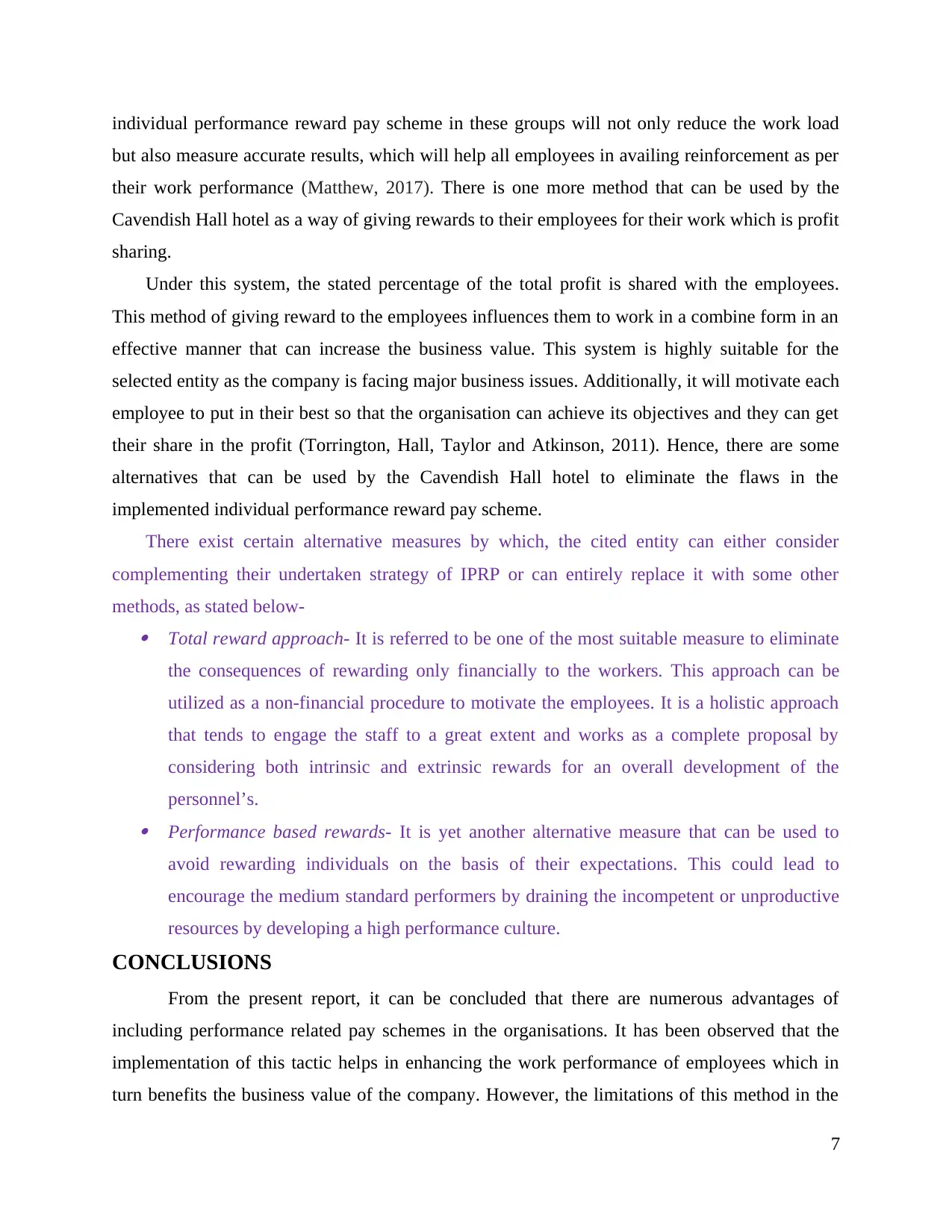
individual performance reward pay scheme in these groups will not only reduce the work load
but also measure accurate results, which will help all employees in availing reinforcement as per
their work performance (Matthew, 2017). There is one more method that can be used by the
Cavendish Hall hotel as a way of giving rewards to their employees for their work which is profit
sharing.
Under this system, the stated percentage of the total profit is shared with the employees.
This method of giving reward to the employees influences them to work in a combine form in an
effective manner that can increase the business value. This system is highly suitable for the
selected entity as the company is facing major business issues. Additionally, it will motivate each
employee to put in their best so that the organisation can achieve its objectives and they can get
their share in the profit (Torrington, Hall, Taylor and Atkinson, 2011). Hence, there are some
alternatives that can be used by the Cavendish Hall hotel to eliminate the flaws in the
implemented individual performance reward pay scheme.
There exist certain alternative measures by which, the cited entity can either consider
complementing their undertaken strategy of IPRP or can entirely replace it with some other
methods, as stated below- Total reward approach- It is referred to be one of the most suitable measure to eliminate
the consequences of rewarding only financially to the workers. This approach can be
utilized as a non-financial procedure to motivate the employees. It is a holistic approach
that tends to engage the staff to a great extent and works as a complete proposal by
considering both intrinsic and extrinsic rewards for an overall development of the
personnel’s. Performance based rewards- It is yet another alternative measure that can be used to
avoid rewarding individuals on the basis of their expectations. This could lead to
encourage the medium standard performers by draining the incompetent or unproductive
resources by developing a high performance culture.
CONCLUSIONS
From the present report, it can be concluded that there are numerous advantages of
including performance related pay schemes in the organisations. It has been observed that the
implementation of this tactic helps in enhancing the work performance of employees which in
turn benefits the business value of the company. However, the limitations of this method in the
7
but also measure accurate results, which will help all employees in availing reinforcement as per
their work performance (Matthew, 2017). There is one more method that can be used by the
Cavendish Hall hotel as a way of giving rewards to their employees for their work which is profit
sharing.
Under this system, the stated percentage of the total profit is shared with the employees.
This method of giving reward to the employees influences them to work in a combine form in an
effective manner that can increase the business value. This system is highly suitable for the
selected entity as the company is facing major business issues. Additionally, it will motivate each
employee to put in their best so that the organisation can achieve its objectives and they can get
their share in the profit (Torrington, Hall, Taylor and Atkinson, 2011). Hence, there are some
alternatives that can be used by the Cavendish Hall hotel to eliminate the flaws in the
implemented individual performance reward pay scheme.
There exist certain alternative measures by which, the cited entity can either consider
complementing their undertaken strategy of IPRP or can entirely replace it with some other
methods, as stated below- Total reward approach- It is referred to be one of the most suitable measure to eliminate
the consequences of rewarding only financially to the workers. This approach can be
utilized as a non-financial procedure to motivate the employees. It is a holistic approach
that tends to engage the staff to a great extent and works as a complete proposal by
considering both intrinsic and extrinsic rewards for an overall development of the
personnel’s. Performance based rewards- It is yet another alternative measure that can be used to
avoid rewarding individuals on the basis of their expectations. This could lead to
encourage the medium standard performers by draining the incompetent or unproductive
resources by developing a high performance culture.
CONCLUSIONS
From the present report, it can be concluded that there are numerous advantages of
including performance related pay schemes in the organisations. It has been observed that the
implementation of this tactic helps in enhancing the work performance of employees which in
turn benefits the business value of the company. However, the limitations of this method in the
7
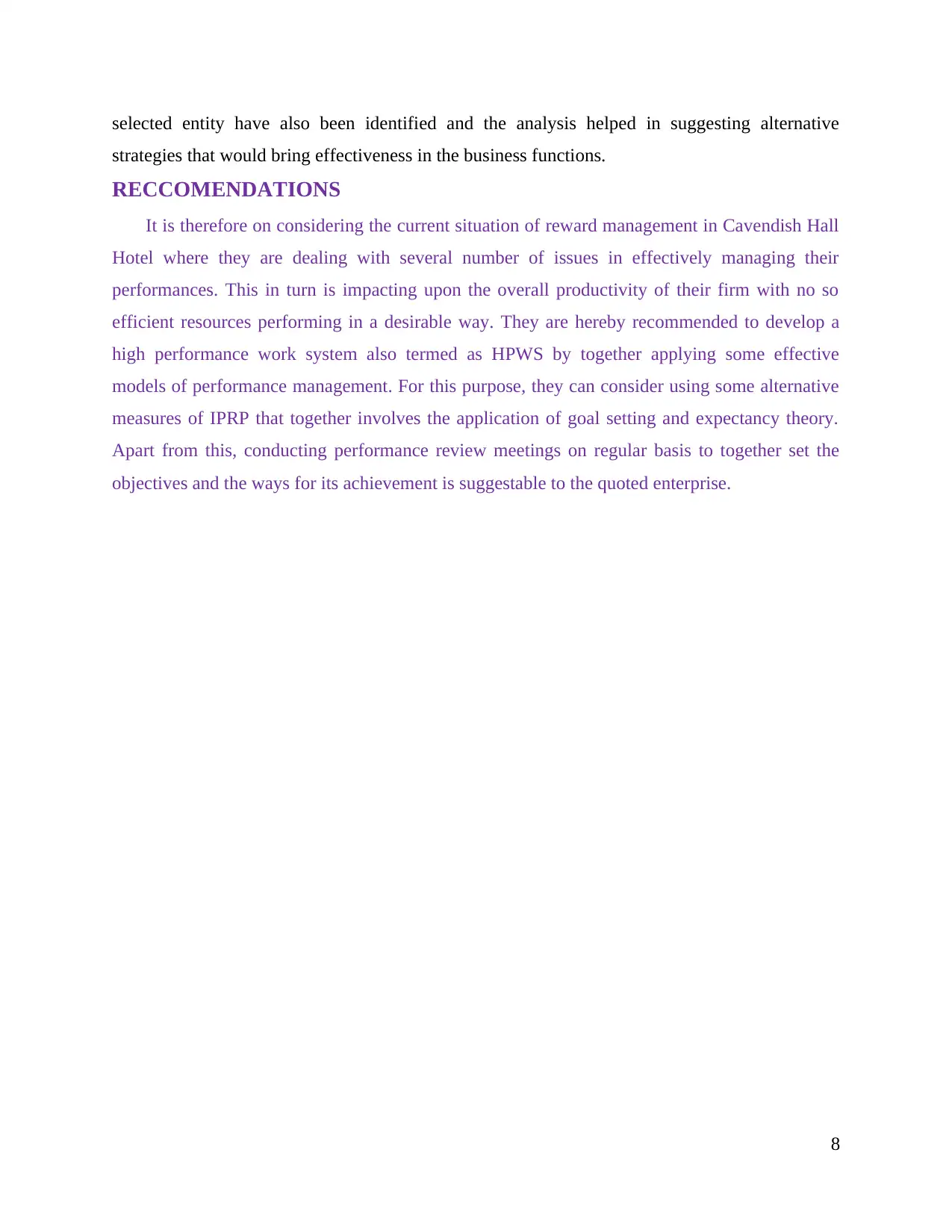
selected entity have also been identified and the analysis helped in suggesting alternative
strategies that would bring effectiveness in the business functions.
RECCOMENDATIONS
It is therefore on considering the current situation of reward management in Cavendish Hall
Hotel where they are dealing with several number of issues in effectively managing their
performances. This in turn is impacting upon the overall productivity of their firm with no so
efficient resources performing in a desirable way. They are hereby recommended to develop a
high performance work system also termed as HPWS by together applying some effective
models of performance management. For this purpose, they can consider using some alternative
measures of IPRP that together involves the application of goal setting and expectancy theory.
Apart from this, conducting performance review meetings on regular basis to together set the
objectives and the ways for its achievement is suggestable to the quoted enterprise.
8
strategies that would bring effectiveness in the business functions.
RECCOMENDATIONS
It is therefore on considering the current situation of reward management in Cavendish Hall
Hotel where they are dealing with several number of issues in effectively managing their
performances. This in turn is impacting upon the overall productivity of their firm with no so
efficient resources performing in a desirable way. They are hereby recommended to develop a
high performance work system also termed as HPWS by together applying some effective
models of performance management. For this purpose, they can consider using some alternative
measures of IPRP that together involves the application of goal setting and expectancy theory.
Apart from this, conducting performance review meetings on regular basis to together set the
objectives and the ways for its achievement is suggestable to the quoted enterprise.
8
Secure Best Marks with AI Grader
Need help grading? Try our AI Grader for instant feedback on your assignments.
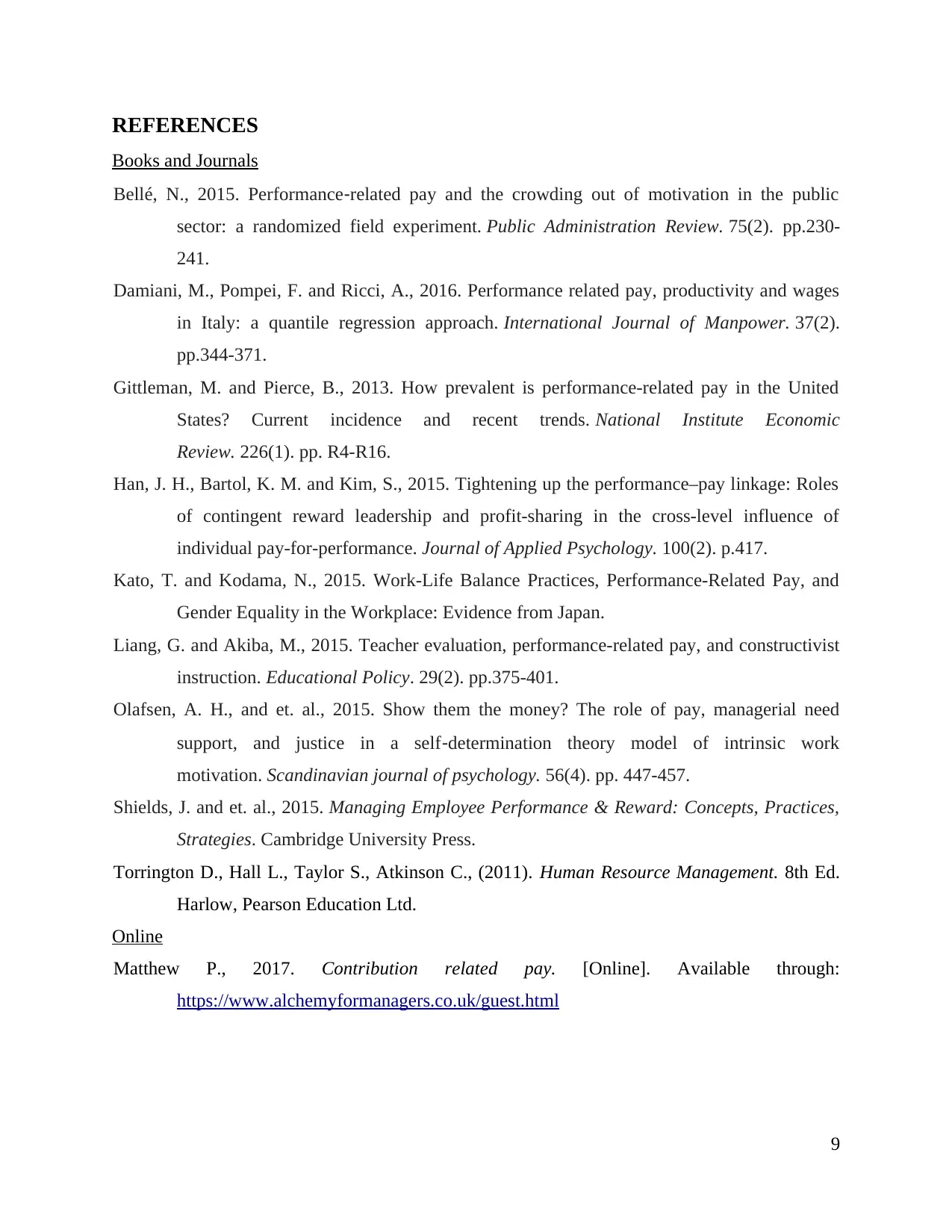
REFERENCES
Books and Journals
Bellé, N., 2015. Performance‐related pay and the crowding out of motivation in the public
sector: a randomized field experiment. Public Administration Review. 75(2). pp.230-
241.
Damiani, M., Pompei, F. and Ricci, A., 2016. Performance related pay, productivity and wages
in Italy: a quantile regression approach. International Journal of Manpower. 37(2).
pp.344-371.
Gittleman, M. and Pierce, B., 2013. How prevalent is performance-related pay in the United
States? Current incidence and recent trends. National Institute Economic
Review. 226(1). pp. R4-R16.
Han, J. H., Bartol, K. M. and Kim, S., 2015. Tightening up the performance–pay linkage: Roles
of contingent reward leadership and profit-sharing in the cross-level influence of
individual pay-for-performance. Journal of Applied Psychology. 100(2). p.417.
Kato, T. and Kodama, N., 2015. Work-Life Balance Practices, Performance-Related Pay, and
Gender Equality in the Workplace: Evidence from Japan.
Liang, G. and Akiba, M., 2015. Teacher evaluation, performance-related pay, and constructivist
instruction. Educational Policy. 29(2). pp.375-401.
Olafsen, A. H., and et. al., 2015. Show them the money? The role of pay, managerial need
support, and justice in a self‐determination theory model of intrinsic work
motivation. Scandinavian journal of psychology. 56(4). pp. 447-457.
Shields, J. and et. al., 2015. Managing Employee Performance & Reward: Concepts, Practices,
Strategies. Cambridge University Press.
Torrington D., Hall L., Taylor S., Atkinson C., (2011). Human Resource Management. 8th Ed.
Harlow, Pearson Education Ltd.
Online
Matthew P., 2017. Contribution related pay. [Online]. Available through:
https://www.alchemyformanagers.co.uk/guest.html
9
Books and Journals
Bellé, N., 2015. Performance‐related pay and the crowding out of motivation in the public
sector: a randomized field experiment. Public Administration Review. 75(2). pp.230-
241.
Damiani, M., Pompei, F. and Ricci, A., 2016. Performance related pay, productivity and wages
in Italy: a quantile regression approach. International Journal of Manpower. 37(2).
pp.344-371.
Gittleman, M. and Pierce, B., 2013. How prevalent is performance-related pay in the United
States? Current incidence and recent trends. National Institute Economic
Review. 226(1). pp. R4-R16.
Han, J. H., Bartol, K. M. and Kim, S., 2015. Tightening up the performance–pay linkage: Roles
of contingent reward leadership and profit-sharing in the cross-level influence of
individual pay-for-performance. Journal of Applied Psychology. 100(2). p.417.
Kato, T. and Kodama, N., 2015. Work-Life Balance Practices, Performance-Related Pay, and
Gender Equality in the Workplace: Evidence from Japan.
Liang, G. and Akiba, M., 2015. Teacher evaluation, performance-related pay, and constructivist
instruction. Educational Policy. 29(2). pp.375-401.
Olafsen, A. H., and et. al., 2015. Show them the money? The role of pay, managerial need
support, and justice in a self‐determination theory model of intrinsic work
motivation. Scandinavian journal of psychology. 56(4). pp. 447-457.
Shields, J. and et. al., 2015. Managing Employee Performance & Reward: Concepts, Practices,
Strategies. Cambridge University Press.
Torrington D., Hall L., Taylor S., Atkinson C., (2011). Human Resource Management. 8th Ed.
Harlow, Pearson Education Ltd.
Online
Matthew P., 2017. Contribution related pay. [Online]. Available through:
https://www.alchemyformanagers.co.uk/guest.html
9

10
1 out of 12
Related Documents
Your All-in-One AI-Powered Toolkit for Academic Success.
+13062052269
info@desklib.com
Available 24*7 on WhatsApp / Email
![[object Object]](/_next/static/media/star-bottom.7253800d.svg)
Unlock your academic potential
© 2024 | Zucol Services PVT LTD | All rights reserved.




